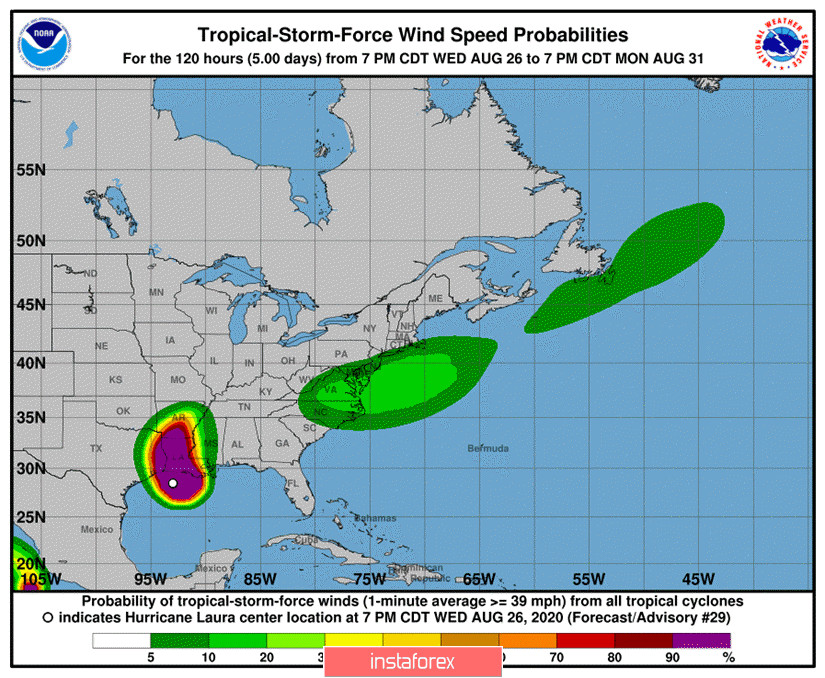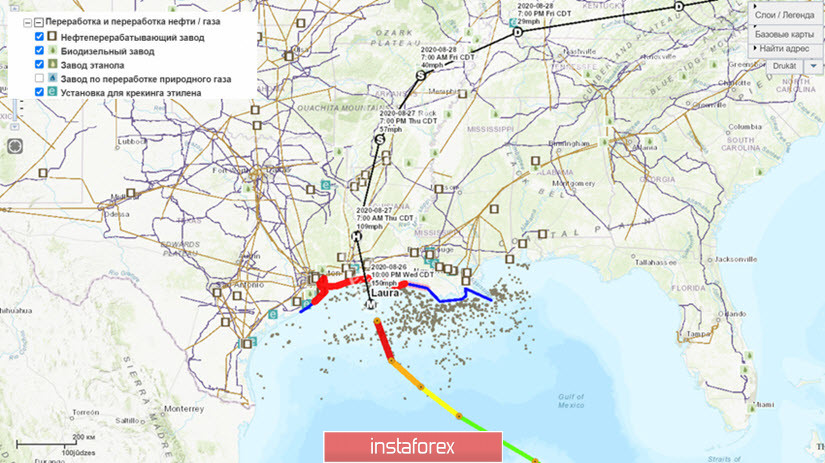Hi dear colleagues! Today I'd like to expand on one interesting issue. Well, I want to dispel the myths of financial markets. Understanding of this question will prompt you to make the right trading decision on oil. Let's discuss how hurricanes impact on oil prices. The first thing to bear in mind is that the seasonal factor is not crucial for the oil market. Nevertheless, it makes sense to adjust your trading decision to this factor if you trade in the commodity market. So, I invite you to figure out how exactly adverse weather conditions influence oil prices.
It is common knowledge that Atlantic storms and hurricanes rage along the Southeastern coast of the Mexican Gulf from July through November. The peak of hurricanes falls on mid-September. The basic routes come from the South towards the North and from the Southeast towards the Northwest. These routes spread across the Mexican Gulf, the Caribbean islands, and the costal line of the US. The most vulnerable states to the disaster are the following: Florida, Alabama, Mississippi, Louisiana, and Texas. Besides, some other states can also fall prey to tropical storms like Georgia, South Carolina, Arkansas, and Oklahoma.
The authorities founded influential research facilities like the National Hurricane Center and Central Pacific Hurricane Center to prevent damage from natural disasters. Such research stations monitor hurricanes online and post forecasts which enable state authorities and emergency forces to take precautionary measures and minimize damage. Here is the map as of August 26 provided by one of such stations when the hurricane called Laura hit the Southern shore of the US (picture 1).
Picture 1. Map of Laura developments as of August 26, 2020

As you can see, the states of Louisiana, Mississippi, Texas and Arkansas suffered the most from Hurricane Laura. The problem with oil prices is that these states are known as the cluster of oil production and processing facilities which is clearly seen on the map provided by the US Department of Energy (picture 2). In addition, oil and petroleum products import / export routes run along the Southern coast of Florida.
No wonder, when a hurricane or storm hits the coast of the Gulf of Mexico, extraction and processing of oil is brought to a halt in this period. The trader's simple logic enables the conclusion: since drilling platforms in the Gulf of Mexico are closed and oil production is suspended, then oil will get more expensive. The same conclusions are made by some media outlets, but these conclusions are not entirely correct, or rather, completely wrong.
Let's take a look at the US Department of Energy map again (Picture 2). Of course, at first glance, the concentration of oil producing wells in this region is enormous. At the same time, not only production, but also refining is important for oil prices. We all remember that in March and April this year, oil prices collapsed into the negative zone exactly because of the overflow of storage facilities, which, in turn, was caused by the shutdown of the global economy amid the COVID-19 pandemic.
Picture 2. Forecast of Laura prospects for August 26

Here is what the US Department of Energy website writes about the impact of hurricanes Laura and Marco on oil production and refining. Tropical storms Marco and Laura are in or near the US Gulf Coast, where the main US energy infrastructure is located. Besides, several wildfires have affected large areas of California and Colorado. Hurricanes and fires can affect local supply and demand, especially when it comes for transportation of fuel and electricity.
When a hurricane is just approaching the coast, the population is actively stocking up on fuel. However, when a hurricane hits the coast, energy demand plummets. According to the US EIA, the areas most affected by hurricanes account for 17% of oil production and 45% of refining in the United States. This means that suspension of oil production is not as critical for the country as suspension of its processing.
When a hurricane hits the coast of the Gulf of Mexico, significant damage is inflicted on the oil-producing and oil-refining infrastructure. As a result, US companies have no storage facilities for available oil. This pushes oil prices down but it doesn't propel their growth as some mass media announced at the beginning of the week.
During hurricanes, another negative factor is also bearish for oil prices. I mean the end of the high car travel season. Americans go back to work after vacations to work when they actively moved around the country. In October and November, some refineries are closed for preventive maintenance which also negatively affects oil prices. Since oil is traded in futures contracts for a month in advance, oil prices go down two to four weeks earlier than the calendar dates.
Picture 3. Seasonal chart of oil prices. Overall data for decade

Let's consider a seasonal chart (picture 3) showing composite data for ten previous years. The chart reveals that prices in September are usually lower than prices in July, and prices in July are lower than prices in May. The lowest prices are recorded in December-January. However, we should understand that the price dynamic is not exactly the same year after year. As a result of events that cannot be predicted, oil prices can change in any direction. So, at the end of this week, we see a slight increase in oil prices. On the other hand, according to the theory of the seasonal factor and the impact of hurricanes on supply and demand, one could expect a decline in oil prices.
In addition, the positioning of a trader will also influence his understanding of the current situation. A trader who opens trades at a 15-minute timeframe may see a different picture from that seen by a trader trading at a 4-hour timeframe. However, as follows from the seasonal factor, the decline in oil prices in the second half of the year under the influence of weather conditions can be objective in general and subjective in particular. Therefore, a trader, first of all, should be guided by the signals of his trading system. If something is uncertain, it would be a good idea to pay attention to additional factors, giving them different weight in the algorithm for making trading decisions. Be careful and sensible! Make sure you follow money management rules!





















